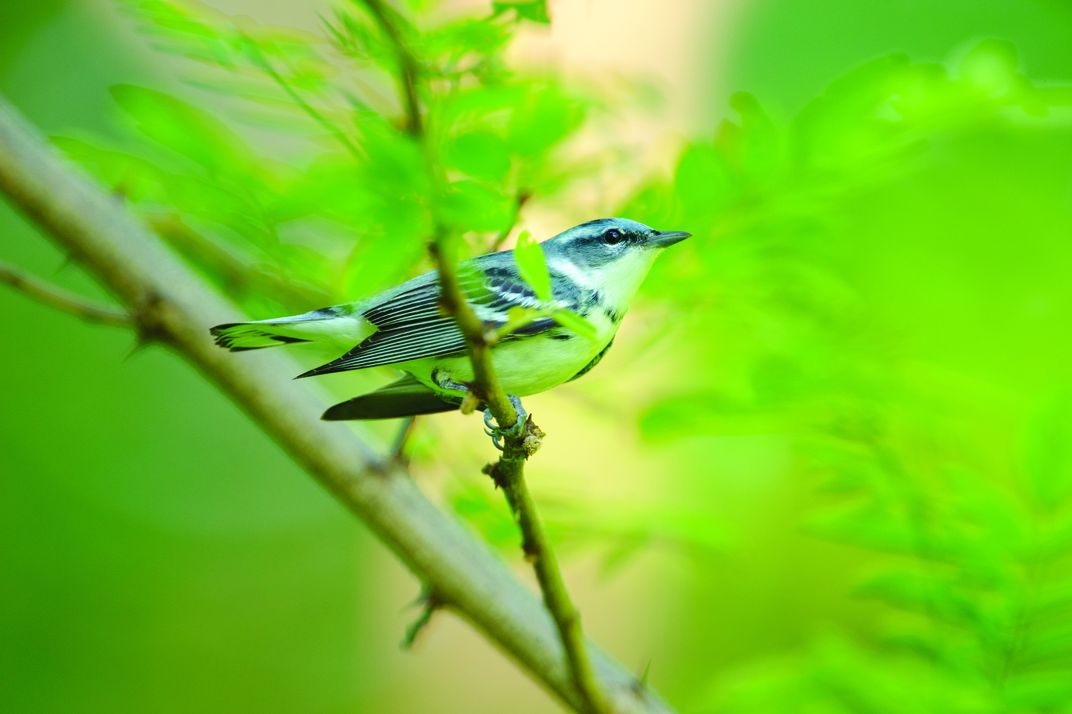The Most Extensive Report Ever on American Birds Says There’s Cause for Concern
Researchers from 23 groups just released the fifth State of the Birds report, which contains good and bad news
:focal(322x352:323x353)/https://tf-cmsv2-smithsonianmag-media.s3.amazonaws.com/filer/f9/82/f982dd8d-230c-4ad1-8ed0-329ac6c9f537/screen_shot_2014-09-08_at_22842_pm.png)
There may have never been a more important time to study birds than now. That’s the idea behind the 2014 State of the Birds report, released this morning and written by the top American ornithologists working today. Some of the findings are cause for celebration. Others have bird experts concerned.
The first State of the Birds came out in 2009, modeled after similar types of reports in Europe. While previous American versions have focused on specific topics related to birds in the United States, such as climate change, this year’s report provides a wider overview. The 16-page document, complete with photographs and illustrations of the feathered creatures, explores population trends and relationships between populations and habitats. The authors come from 23 agencies and organizations, including the Smithsonian Migratory Bird Center, the Fish and Wildlife Service and the American Bird Conservancy.
Bird populations can increase or decrease by as much as three or four percent each year due to factors like land use, unnatural predators and climate change, so it's important for researchers to check in annually. “We need to make sure we have our finger on the pulse to be able to identify and record a significant change when it’s happening,” says Pete Marra, director of the Migratory Bird Center and an author of the report.
Marra helped unveil the report this morning at Smithsonian Castle in Washington, D.C. "Does it matter when we lose a bird, lose a species?" Marra asked a gathering of about 100 people. "Hell, yes, it matters," he said. "They're a constant reminder of how important nature actually is."
Some of the results are troubling. “The news is not good,” Marra explained in an interview earlier in the week. There are 800 million fewer birds in the United States than just 40 years ago, the researchers found. Birds in forest and arid land areas, as well as long distance migrants and seabirds, are all experiencing dramatic declines.
“It’s a cause of great concern,” adds David Pashley of the American Bird Conservancy, another author of the report. Pashley singles out Hawaiian birds as the most threatened bird population in the country, if not the world. Those birds appear on a Watch List, included with the report, which names 230 bird species that are facing threats.
There is some hope. The researchers found that some conservation efforts over the past 30 years have helped stem declining bird populations. “What we as a conservation community have demonstrated is that if we have the political will and the financial resources to take care of a segment of the bird population of this continent, we can do it," Pashley says.
One population that has recovered is wetland birds, which have benefited from costal wildlife refuges. “Nature is quite resilient and when you put in place certain policies,” Marra says, “birds will respond.”
The release of the 2014 report comes as bird conservation is making headlines. Last week marked 100 years since the extinction of the passenger pigeon, which had numbered in the billions just decades before it died out. “In half a person’s lifetime it went from being the most abundant [bird] species in the U.S. to going extinct," Marra says. "It’s a lesson.”
A new exhibition at the National Museum of Natural History, "Once There Were Billions: Vanished Birds of North America," commemorates birds like the passenger pigeon (closing October 2015). Opening October 31 is another bird-related exhibition, "The Singing and the Silence: Birds in Contemporary Art," at the Smithsonian American Art Museum (closing February 22, 2015).
Brad Andres from the Fish and Wildlife Service, also one of the report's authors, says that there are spiritual reasons why people should care about birds. Humans have a responsibility to be “stewards of the world,” he says, “when we’ve been given the intellectual ability to do that.”
/https://tf-cmsv2-smithsonianmag-media.s3.amazonaws.com/accounts/headshot/MAx2.jpg)
/https://tf-cmsv2-smithsonianmag-media.s3.amazonaws.com/filer/fa/df/fadf6a9d-7f54-4476-a394-8d83db3f6c07/greater_prairie-chicken.jpg)

/https://tf-cmsv2-smithsonianmag-media.s3.amazonaws.com/filer/d8/92/d8925fce-8784-49c9-80ab-c07b5aa2b63c/emperor_goose.jpg)
/https://tf-cmsv2-smithsonianmag-media.s3.amazonaws.com/filer/4d/12/4d122a51-25c8-493a-b773-e3aa60890d33/red_knot.jpg)
/https://tf-cmsv2-smithsonianmag-media.s3.amazonaws.com/filer/9b/22/9b22953d-3146-4f79-bb60-65e79860e0ba/iiwi-1_jpg.jpg)
/https://tf-cmsv2-smithsonianmag-media.s3.amazonaws.com/filer/04/60/0460015c-ca15-4ccc-ae4d-419e5c57046d/northern_pintail.jpg)
/https://tf-cmsv2-smithsonianmag-media.s3.amazonaws.com/filer/f9/82/f982dd8d-230c-4ad1-8ed0-329ac6c9f537/screen_shot_2014-09-08_at_22842_pm.png)
/https://tf-cmsv2-smithsonianmag-media.s3.amazonaws.com/accounts/headshot/MAx2.jpg)